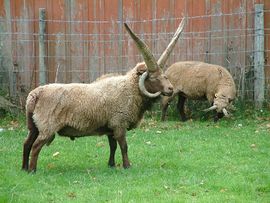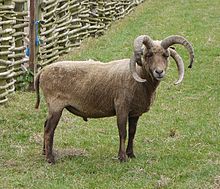- Manx Loaghtan
-
 Manx Loaghtan sheep at The Grove, Rural Life Museum, Ramsey, Isle of Man
Manx Loaghtan sheep at The Grove, Rural Life Museum, Ramsey, Isle of Man
The Manx Loaghtan is a breed of sheep (Ovis aries) native to the Isle of Man. It is sometimes spelled as Loaghtyn or Loghtan. It is characterized by a dark brown wool and usually having four or occasionally six horns.[1]
The Manx Loaghtan is descended from the primitive sheep once found throughout Scotland and the Hebrides and Shetland Islands, and is one of the Northern European short-tailed sheep breeds. The word Loaghtan comes from the Manx words lugh dhoan which means mouse-brown and describes the colour of the sheep.[1] This breed is primarily raised for meat which is considered a delicacy. It has recently received EU recognition and protection under the Protected Designation of Origin scheme which requires products to originate in a specific region such as Champagne.[2]
It is categorised as "at risk" by the Rare Breeds Survival Trust, as there are fewer than 1,500 registered breeding females in the UK.[3]
Contents
Appearance
A Manx Loaghtan at Butser Ancient Farm
It is small, with no wool on the face or legs. The face and the legs are a dark brown colour. Manx Loaghtan are horned with four horns being preferred but individuals are also found with two or six horns. The horns are generally small on the ewes but are larger and stronger on the males.
Loaghtan is farmed as a delicacy on the Isle of Man, with only two principal farms on the island producing the meat. There are now many holdings on the UK mainland that also breed Loaghtans, including some farms with over 100 ewes – for example the Fowlescombe Flock in Devon.[citation needed] This gourmet meat is highly prized, often sold as hoggett or mutton from well finished animals. The wool is prized by craft weavers as it is soft and has a rich brown colour.
There is a large flock of the sheep on the Calf of Man and access to the island was closed to protect them during the 2001 UK Foot and Mouth Disease epidemic. The disease did not reach the island, which continued exports of the meat to the continent of Europe.
The Loaghtan is believed to be the closest surviving relative of the now extinct Jersey sheep. In 2008 the National Trust for Jersey began a programme of introducing Loaghtans into the Island for coastal grazing, a traditional method of vegetation control in the north of Jersey.[4]
See also
References
- ^ a b "Manx Loaghtan". http://www.manxloaghtan.com/. Retrieved 2009-04-21.
- ^ "Manx Loghtan/United Kingdom". Breed Data Sheet. Domestic Animal Diversity Information System. http://dad.fao.org/. Retrieved 2009-09-02.
- ^ "Manx Loaghtan". Rare Breeds Survival Trust watch list. http://www.rbst.org.uk/watch-list/sheep/manxloaghtan. Retrieved 2008-06-08.
- ^ "A place in the country for four-horned sheep". Jersey Evening Post. http://www.thisisjersey.com/2008/05/29/a-place-in-the-country-for-four-horned-sheep/. Retrieved 2009-07-28.
External links
Categories:- Fauna of the Isle of Man
- Sheep breeds
- Ark of Taste foods
- Products with protected designation of origin
Wikimedia Foundation. 2010.

